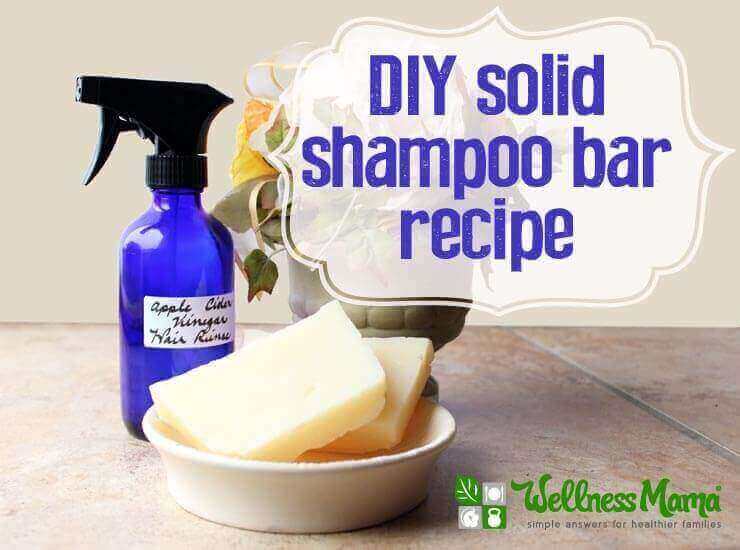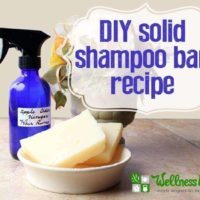When I began my journey to give my family a chemical-free lifestyle I adapted pretty easily to natural cleaners like homemade laundry soap and natural all-purpose cleaners. I drew the line, however, with my own personal hygiene routine.
I have always had oily hair and skin and I was not willing to give up my store-purchased shampoos and face-washes for fear that natural cleaners would not be able to keep my oily hair in check. But as I began to see more information on the chemicals in conventional shampoos, I decided it was time to make the switch.
I also learned that when chemical shampoos strip the natural oils from your hair (which is what I thought I needed) they cause your scalp to overproduce in an attempt to compensate being stripped in the first place. This shocked me. By stripping the oil out of my hair I was actually making it worse!
I first experimented with the no-poo method, but I had disastrous results! I was jealous of people who had success with this method, but I was certainly not one of them. So I went back to my “regular” shampoo and went on the hunt for another option. That is when I stumbled upon solid shampoo. I would have never thought I could use a bar of soap on my hair, but I was excited about the possibility of actually using a soap with a lather to clean my hair.
Benefits of Solid Shampoo
I was pleasantly surprised with how well it worked. It took a while for my hair to fully adjust, but I never felt like I was walking around with unclean hair the way I did when I was trying “no-poo.” And because I was no longer stripping my hair of all it’s natural oils I was able to shampoo less, which was great news for me since I previously would not leave home without washing my hair.
Another perk I experienced was quicker showers. As a mother of 5, this was very important to me. Actually shampooing my hair took the same amount of time, but because I was using an apple cider vinegar rinse as my “conditioner,” it eliminated the lengthy process of letting the conditioner set and then the time it took to rinse it out.
Finally, because the shampoo bar is basically a bar of soap, it can be used on the whole body. This also makes it easy to travel with because all you need is your bar of soap and a small bottle of rinse and you are good to go!
How to Make Solid Shampoo
Soap is made by combining a lye (sodium hydroxide) and water mixture with various oils. A chemical reaction occurs and the oils are saponified giving you soap (no lye remains.) Each oil used in soap making has a different saponification value which means that each oil requires a different ratio of lye to water depending on the amount and type of each oil used.
A soap calculator can help you to figure this out by allowing you to enter the amounts and types of oils you will be using and telling you how much water and lye to use.
Different oils also have different benefits when making soap. For example, coconut oil makes a hard bar that has good cleaning properties while olive oil makes a soft bar with moisturizing benefits. The trick to soap making is to find the right combination of oils to give you a perfect balance for your needs. For our shampoo bar we are going to use:
- olive oil
- coconut oil
- castor oil
- tallow (You can get it here) -Palm oil can be substituted for the tallow for a purely vegetable soap.
Coconut oil-makes a nice hard bar that cleans and lathers well, but it can be drying so it is recommended to use no more than 30%.
Olive oil-makes a softer bar that has wonderful moisturizing properties, but does not give much of a lather. Up to 50% is recommended.
Castor oil-helps stabilize the lather created by the other oils. While it is recommended to use no more than 10% because too much castor oil can make your bar feel sticky, we are going to use slightly more in this recipe because the lathering properties really help when working the soap through your hair. I have never had a problem with my shampoo bar feeling sticky.
Tallow-makes a hard bar with great cleansing properties. Use up to 50%. (I rendered the beef fat from a cow we had butchered to make tallow. You can substitute palm oil in this recipe which has the same benefits as beef tallow. Just be sure to recalculate your ingredients to be sure your lye/water ratio is accurate.)
Essential oils also make a wonderful addition to shampoo bars, but are not necessary. I have used a combination of tea tree, rosemary, and peppermint and also peppermint and orange. Both were lovely.
Shampoo Bar Supplies
I have bowls/spoons designated only for soap making because we are working with lye and I don‘t feeling comfortable using these bowls for food.
- Glass or high quality plastic mixing bowl for mixing lye and water (I use a qt. mason jar)
- Non-reactive pot or crockpot for warming oils
- Candy thermometer (I have two, one for the lye mixture and one for the oils)
- A soap mold (I use a silicone bread mold)
- Digital scale for precise measuring
- Stick blender
- Wooden spoon
- Gloves and protective eyewear
- White Vinegar (good to have on hand to neutralize lye in case of spills)
DIY Shampoo Bar Recipe
Materials
- 12 oz distilled water
- 5 oz lye
- 10 oz coconut oil
- 10 oz tallow (or palm oil)
- 10 oz olive oil
- 6 oz castor oil
- 1.5 oz essential oils (optional, see notes)
Instructions
- Wearing protective gloves and eyewear, pour the distilled water into a glass bowl/jar for mixing.
- In a well-ventilated area, slowly add the lye to the water. (They must be mixed in this order. DO NOT add water to the lye.) This causes the mixture to become very hot so keep that in mind for protecting the surface of your work area. Stir and let sit to give time for the reaction to take place and for it to cool back down. I use the candy thermometer to keep track of the temperature.
- Meanwhile, measure the coconut oil, tallow or palm oil, olive oil, and castor oil using a digital scale.
- Combine them in a non-reactive pot or Crock Pot and begin to slowly warm the oils.
- You ideally want your oils and your water/lye mixture to be about the same temperature when you mix them (between 100 and 120 degrees). When the temperatures are close, slowly add the water/lye mixture to the warmed oils.
- Use a stick blender to begin mixing until trace is achieved. You can tell when you have reached trace when your mixture is still fluid, but a drop or drizzle of the soap mixture stays on the surface for a few seconds before falling back in. [Just pull your immersion blender (in the off position) up and let some soap drizzle off.]
- Add the essential oils if you are using them.
- Pour the mixture into a soap mold. *Remember, saponification is not complete yet at this point so you still want to be wearing your gloves/eyewear.
- Cover the soap mold with an upside down cardboard box and cover with a towel to keep it warm while it continues to saponify and leave for 24 hours. If your home is particularly warm you may not need the towel. If it gets too warm it could crack, which I don’t think would cause a problem but your soap won’t be as pretty.
- While still wearing gloves, wash all utensils in hot, soapy water. You can add some vinegar to your hot, soapy water to help neutralize the lye.
- After 24 hours, remove the soap from the mold and slice it. I cut mine about 1 inch thick.
- Stand the bars upright and let them cure in a well-ventilated area for about 4-6 weeks and then enjoy!
Notes
See the section above for more information on equipment. No time to DIY? My (Katie’s) Wellnesse Cleansing Shampoo is another great option!
How to Use Solid Shampoo
Solid shampoo is used much like any bar of soap. Get your hair wet and begin to rub the bar over your hair until you have a nice lather. Now you can massage and lather your hair as if you were using “real” shampoo. Rinse with water.
Most people need to follow with an acidic rinse such as apple cider vinegar or lemon juice mixed with water. People with drier hair may try up to a 50/50 mix.
Because I have oily hair I use less ACV. I mix about 1/3 cup ACV in a 20 oz spray bottle and fill the rest of the way with water. It is roughly a 1/5 ratio. You can also add essential oils to make it smell wonderful. I use 10 drops each of rosemary and peppermint.
After you are done shampooing, just spray this all over your hair and leave it in. The vinegar smell dissipates as it dries and you are left with the lovely smell of essential oils.
Update from Katie: My personal care products line Wellnesse doesn’t have shampoo bars (yet), but if you want a non-DIY option try the 100% all natural, biodegradable shampoo bar from Morrocco Method.
Ever tried natural shampoo? What worked for you?



Leave a Reply